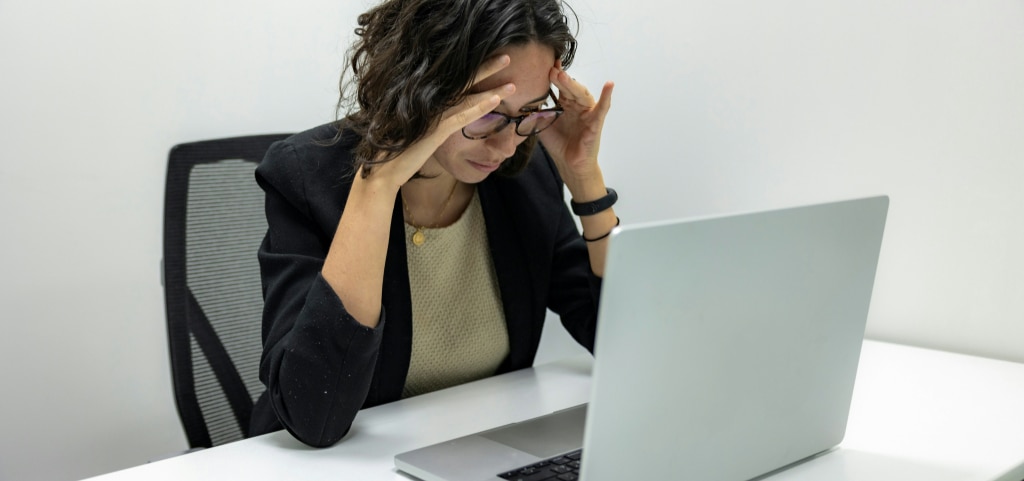Our eyes help us to see and experience the world around us. They deserve to be taken care of and given plenty of time to rest. In this article, we will explain how best to cure your fatigue and relax your eyes.
There are many different reasons why our vision deteriorates over time. It is not just a result of loss of vision or the aging eye, in fact one of the biggest issues is that in recent years, many of our lifestyles have become increasingly more stationary. Endless hours spent working on computers, binge-watching our favourite TV shows, scrolling through our phones, plus exposure to air conditioning, fluorescent lighting and a general lack of exercise have led us to put a lot of extra strain our eyes. That is why it is so important, now more than ever, that you give your eyes time to rest. This National Relaxation Day, follow our advice as we reveal all the secrets to looking after your vision and relaxing your eyes.

What are the symptoms of eye strain and visual fatigue?
Digital eye strain, or Computer Vision Syndrome (CVS) as it is also referred to, can result in a variety of symptoms, including but not limited to, blurry vision, dry and/or scratchy eyes, headaches and neck and/or shoulder pain.
How to relieve eye strain
Discover some of the best ways to give your tired eyes a well-earned break. Follow our top tips to relaxing your eyes.

Optimise your glasses
Safeguard your vision by adding blue-violet light lenses to your chosen frames. These are designed to reduce glare and ensure improved visual comfort when you are using your digital devices.
Additionally, a majority of our reliable lens packages come complete with an anti-reflection coating that prevents troublesome reflections and keeps your eyes protected.
When using a computer, it is best for you to take your contact lenses out and wear glasses instead. Contact lenses can become dry and begin to feel uncomfortable during long periods of computer use.
If you prefer to wear multifocal lenses on a daily basis, but do not find them comfortable for lengthy computer use, it might be worth considering getting a pair of glasses with just a single prescription in them to use solely with your devices.

Take regular breaks from your screen
Ensure that you stay disciplined and dedicate time away from your screen. Many experts believe that when using a digital device, it is important to take frequent breaks. This is because the rate in which your eyes blink is greatly reduced when focusing on digital screens which can result in eye strain.
The 20-20-20 rule is our best recommendation for keeping on top of this. Take a break for 20 seconds and focus your sight on an object around 20 feet away. Repeat this every 20 minutes. Another great tip is that for every two hours you spend in front of a screen, give your eyes a 15-minute rest. Grab yourself some water or stretch your legs a little if it helps!

Alter the lighting around you
The appropriate lighting will depend on what activity you are enjoying at the time. When using your digital devices, try to minimise the amount of light above you and ensure any natural light is to one side and not right in front of you. This will help to prevent glare on your screen so you are not straining to see.
If you are watching TV, make sure the room is dimly lit. This will be much easier on your eyes. If you are reading a book, meanwhile, we suggest that you place the light behind you so that it is pointing on the page rather than directly in your eyes.

Adjust the display on your digital devices
Changing the settings on your tablet, smartphone or laptop screen can really help to relieve symptoms of eye strain and tired eyes. Ensure the brightness of your screen matches your surroundings at the time. You should also adjust the screen size and contrast to make sure that you can see clearly and are not straining your eyes. On some devices, you can also lower the amount of blue-violet light that is emitted by the screen. There are even glare filters which help you to see clearer by reducing the amount of glare from your digital screen.

Make sure you are sitting comfortably
Make sure that your chair is correctly positioned and the centre of the screen is within your line of sight or just below and also an arm’s length away (approx. 20 to 28 inches) from your eyes. You should also keep a good posture regardless of whether you are working or relaxing with your digital devices. Adjust your chair and ensure that your feet are firmly on the ground.

Pay attention to how often you blink
Without being too obsessive about the process, blinking your eyes more often will help to lubricate them with tears. If you spend a long time focusing on one particular thing without blinking your eyes, it can leave them feeling very dried out and therefore irritated. Focusing on digital screens for a long time can dramatically lower your blink rate from around 20bpm to 6–8bpm. So, next time you feel your eyes straining, take that as a sign you need to blink more.

Use eye drops to lubricate your eyes
One of the best ways to treat your dry, fatigued eyes is by using eye drops which you can normally get over the counter at most local pharmacies. These will help to moisten your eyes and get rid of any symptoms. Your healthcare provider may also suggest alternative prescription medications if your condition is more severe.

Enhance the moisture in the air
Dry eyes can lead to a real sense of fatigue. A humidifier will help to boost the amount of moisture in the air as well as in your eyes. You should also use your thermostat to alter the temperature and try not to sit near vents where dry air is likely to blow directly into your face.

Use a warm, damp flannel
If you are experiencing tired, achy eyes then putting a flannel or cloth over them can help to relieve the symptoms. This is perhaps one of the best home remedies you can use to relax your eyes. The warmth of the cloth helps to create moisture in your eyes and soothe the muscles.
Begin by washing your hands thoroughly to avoid any bacteria coming into contact with your eyes. Next, boil some water so that it is sterilised and allow it to cool in a bowl. Once the water is tepid, soak a clean flannel or wash cloth in it and wring it out. Finally, put it over your eyes for around 10 to 15 minutes.

Flex your eye muscles with exercises
It can really help to give the muscles in your eyes a workout from time to time. One method of doing this is to hold your index finger out a few inches in front of your eyes. Get your eyes to focus on your finger. Then, focus them beyond to the distance and then back on your finger. Repeat these steps a few times.
Alternatively, close your eyes and then roll them upwards towards where the ceiling is. Next, roll them downwards in the direction of the floor. Look right and then left. Repeat each action three times. Try to do this as frequently as you can to minimise any discomfort you are experiencing. The eye movement will help spread tears across your eyes.
It is important to be aware that these exercises can help to relieve tired eyes but they will not make your eye muscles any stronger.
What should I do if I am experiencing blurry vision?
If you are suffering from prolonged eye strain and discomfort and you have noticed your vision is blurry, this could be a sign that you need a new prescription or it could indicate other health issues like Age-related Macular Degeneration (AMD) or cataracts. It is important that you get regular eye tests to ensure your eyes are healthy and to check for other potential health conditions.




